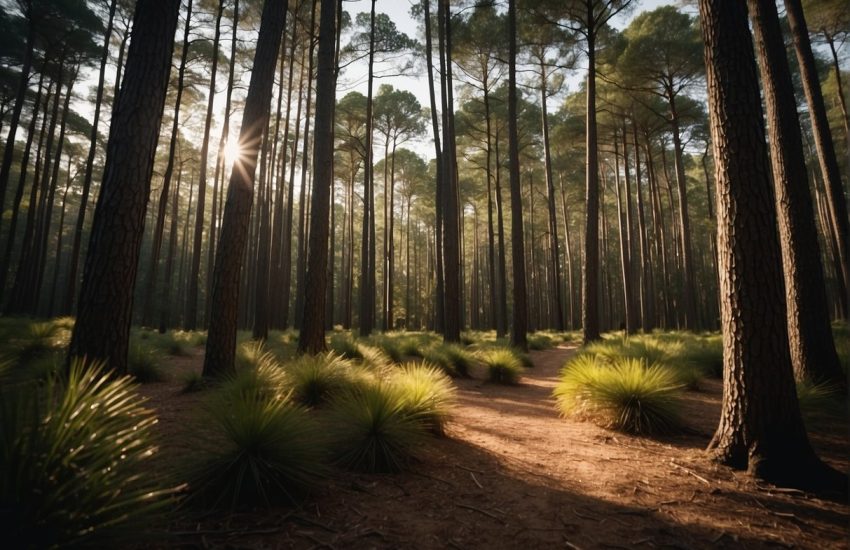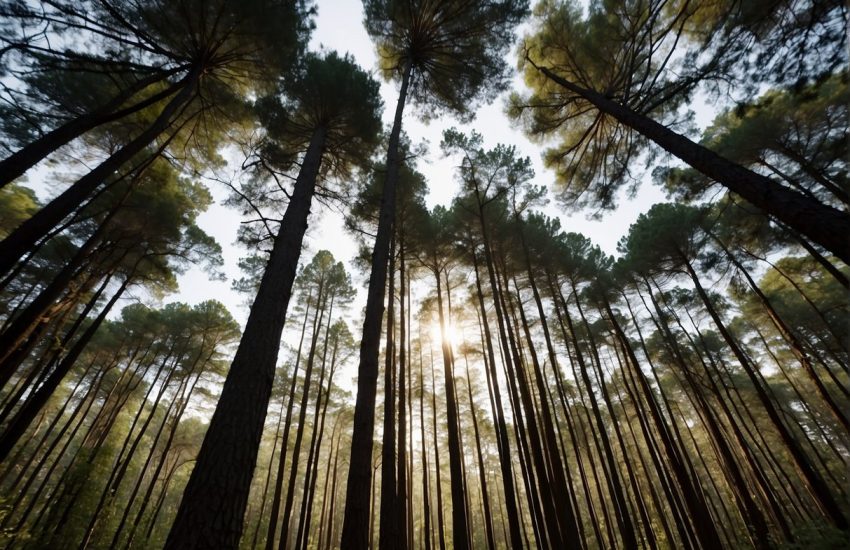Best Evergreen Trees to Grow in Illinois
The landscape around a home is made alive by trees, bushes, and annual plants. Choosing which tree to plant might be difficult because there are so many different kinds, especially if you have little room.
Trees classified as evergreens keep their leaves all year long. These trees can be used as hedges, privacy screens to filter out annoying noises, or to delineate property limits. Check the hardiness map of Illinois to see which evergreen trees will thrive in your Illinois yard. Make sure to pick trees that are appropriate for your zone.
Trees and bushes are beloved by all. They provide your environment with a ton of variety, height, texture, and color. However, so many possibilities are available that it might be challenging to select one when planting a tree or shrub. Let's look at the best evergreen trees in Illinois to inspire you.
15 Evergreen Trees to Grow in Illinois
A distinctive and lovely element to any Illinois landscape is evergreen trees. Illinois residents are guaranteed to find an evergreen ideal for their landscape thanks to the wide variety of species that are readily accessible.
1. Green Giant Arborvitae
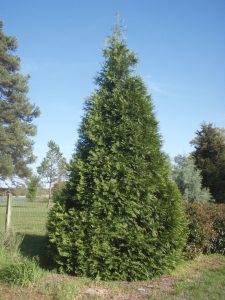
The Green Giant Arborvitae can grow between three and five feet yearly and is a very well-liked landscape tree in the US. It has a robust pyramidal shape that acts as a strong emphasis in the surrounding environment. The feather-like leaves emerge at the base of the trunk and keep their green color throughout the chilly winter.
The Green Giant Arborvitae is ideal for privacy screening because of its quick growth, compact structure, and stunning evergreen leaves. It may also be used to block out any unwanted views or curious eyes.
2. Canadian Hemlock
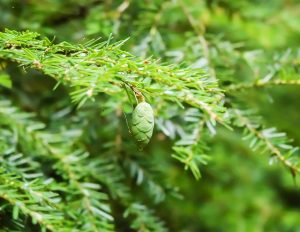
The Canadian Hemlock is a tall tree with a strong central trunk and a pyramidal structure. Short, dark green needles that are gray on the underside make up the foliage. Older trees can get lovely reddish-cinnamon furrowed bark. The optimal conditions for Canadian hemlock growth are moist, well-drained soil.
They can be pruned to the shape you choose, but if left unpruned, they have a lovely airy form. Throughout the winter, various birds and small mammals have a place to call home thanks to these indigenous of North America.
3. Eastern Red Cedar
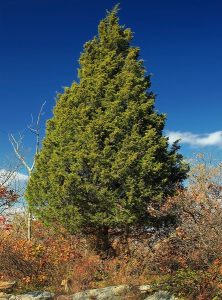
The Eastern Red Cedar, a hardy tree that is native to the Eastern Seaboard, Texas in the west, and South Dakota in the north, thrives in a variety of harsh environments. They can withstand extreme heat, arid, poor soils, air pollution, and other challenging circumstances. The foliage is a strange shade of purple in the winter and a dark green/silvery blue in the summer.
The Eastern Red Cedar is the perfect tree for those who enjoy watching birds since it draws various local birds, including waxwing, songbirds, warblers, grouse, wild turkeys, sparrows, and more, who will roost and nest among the branches.
Birds use the reddish-brown bark to construct their nests. Female plants produce little, berry-like cones that are also a source of food for birds. The Eastern Red Cedar thrives in dry and moist soil so long as it isn't constantly wet.
Cryptomeria Yoshino
4. 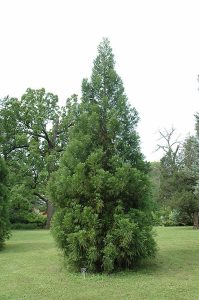
If you need a windbreak or privacy tree for a shady area, the Cryptomeria Yoshino is ideal. They are tall, dense conifers with tiers of horizontal branches that exhibit bluish-green summer foliage and purple or golden winter foliage when exposed to chilling winds. They grow quickly and take on a pyramidal shape that landscapers like.
The soil types that Cryptomeria Yoshino can tolerate are numerous and can grow in either full sun or shade.
5. Leyland Cypress Tree
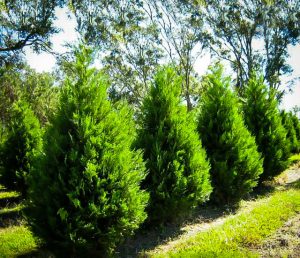
One of the coniferous evergreen trees most frequently planted in the US is the Leyland Cypress. It is a cross between the Nootka False Cypress and the Monterey Cypress.
Due to its dense foliage and ability to grow 3-5 feet per year, it offers a dense screen. Once established, it can withstand drought conditions and doesn't need much upkeep unless you wish to train it into a hedge. If let grows on their own, they develop into an attractive symmetrical shape. Sandalwood and clay soils are two types of soil that Leyland Cypresses can grow on.
6. Black Hills Spruce
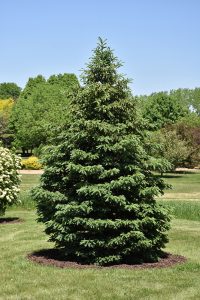
The Black Hills Spruce can survive Illinois' harsh winters because it is a native of some of the country's coldest regions. They are favored as an accent and privacy tree because of their cone-shaped, compact growth habit and dark green foliage.
The Black Hills Spruce adapts well to urban environments because it can withstand salt and drought once established. Plant in regions with cool summers and cold winters for the most significant benefits.
7. Norway Spruce
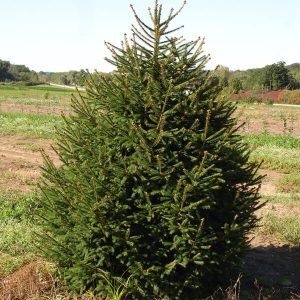
The Norway spruce makes an excellent accent tree or windbreak in chilly climates. This tree has tall branches draped in drooping secondary branches that give its silhouette a careless ease. Its growth pattern is pyramidal, even when it is young. The cylindrical seed cones droop lazily from the lateral branches.
8. Spartan Juniper
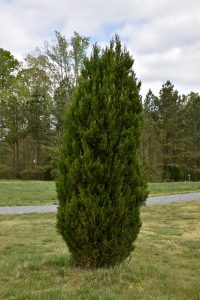
The Spartan Juniper grows quickly and in an erect stance. It is a tough plant that thrives in the harsh urban environment since it can withstand heat, cold, salt, drought, and practically all soil types. Because of its columnar, dense growth, it can be used as a windbreak, privacy screen, or hedge. Due to its durability and adaptability, the Spartan Juniper is arguably the most well-known juniper.
9. Serbian Spruce
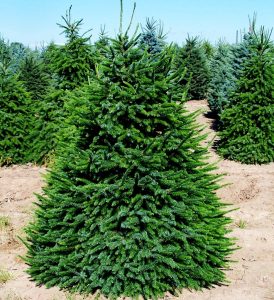
The Serbian Spruce is a beautiful tree with curved branches, a narrow, straight stem, and a pyramidal shape. The cinnamon/purple cones grow to a dark brown color, and the needles have a pale green/blue color. The flat, dark green needles can grow up to an inch long. Salt is the one urban condition it won't tolerate. The Serbian Spruce should be planted in deep, moist, well-drained soil with shade or full sun. It develops at a modest to moderate rate.
10. Colorado Spruce
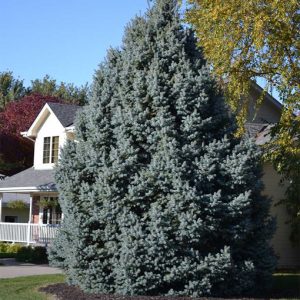
For individuals looking for a windbreak in chilly climates, the Colorado Spruce is ideal. Even when it is young, the conifer has a pyramidal shape.
This spruce tree has an erect branching structure with drooping secondary branches. Wild songbirds can find food and a home in the seed cones that gracefully dangle from the drooping branches. The Colorado Spruce may grow up to 2 feet yearly, which is a reasonably quick growth rate. It thrives on soils that are well-drained and somewhat damp.
11. Austrian Pine
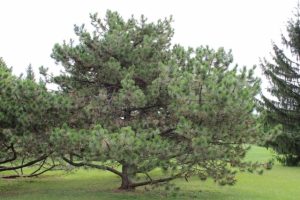
The Austrian Pine is an excellent option for windbreaks because it has been tested in the windiest regions of the nation and thrived there. These pine trees can withstand various soil types, including clay-rich and low soils, and urban pollutants. They are resistant to even strong salt sprays. Water well at first. Once planted, it should survive on rains alone, though it will enjoy additional water during prolonged hot and dry spells.
12. Bald Cypress
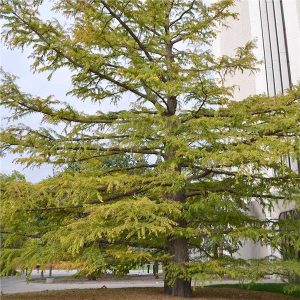
The bald cypress is a deciduous conifer that grows in marshes all around Illinois. It is a tree that grows quickly and can become as high as 60 to 70 feet. The needle-like leaves of the bald cypress become a lovely bronze color in the fall.
The bald cypress is excellent for low places that frequently flood from Illinois streams or wetland areas. It is a flexible addition to any Illinois landscape because it is tolerant of poor soil conditions.
13. Sweetbay Magnolia
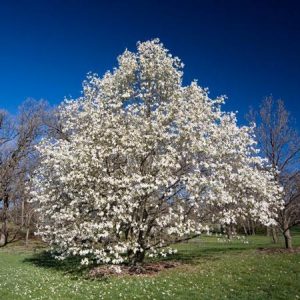
An abundant deciduous tree in Illinois is the Sweetbay magnolia. It produces stunning, scented blossoms that might be white, pink, or purple. The Sweetbay magnolia has large, luscious leaves that turn golden in the fall and reaches a height of 30 to 40 feet.
In Illinois, the Sweetbay magnolia is a beautiful addition to any landscape. It is well suited to the Illinois landscape since it can survive poor soil conditions and thrives in the state's climate.
14. Douglas Fir
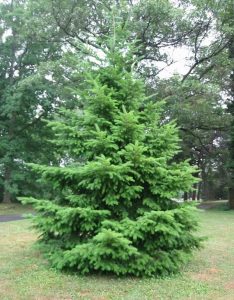
The Pacific Northwest native Douglas fir is not adapted to the climate of Illinois. It may reach heights between 200 and 300 feet and has long delicate needles. The Douglas fir is a great option for homeowners in regions with chilly winters.
15. Carolina Hemlock
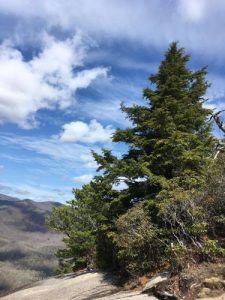
Fast-growing evergreens include the Carolina hemlock. It has blue-green needles that can reach a length of one inch. The Carolina hemlock's capacity to withstand the winters and summers in Illinois and its resilience to disease and insects will be valued by Illinois homeowners.
The Best Trees for Planting in Illinois
Whether you live in the middle Plains, the Shawnee Hills, or the Gulf Coastal Region, shade trees are a must during the Illinois summer. Pay attention to the American Beech, which offers substantial shade, or the Hybrid Poplar, one of the prettiest and fastest-growing trees available. The Nules Clementine fruit tree is perfect if you're searching for a fruit tree to add to your summer garden. Despite being modest, this tree quickly fills up with fruit every summer. It adds a splash of color to your patio.
Check out the living fences if you want more privacy for your home without having to gaze at a dull wall or fence. The most well-known evergreen in the country is Thuja Green Giant, which may grow up to 5 feet a year. The Willow Hybrid and American Holly are additional resilient choices.
Conclusion
Evergreens offer color, habitat, and food when other deciduous trees have gone dormant for the winter. They can also be used as windbreaks to shield other more fragile plants and trees in the backyard from obtrusive sights and sounds. When selecting specific Illinois evergreen trees for your home's landscape, consider the local climate. Evergreens can help block the brisk northern winds by being planted on the north side of your property as a windbreak, increasing the energy efficiency of your home. Evergreens also offer some relief from Illinois's long, lonely winters by bursting with color at specific points during the long, cold season.

